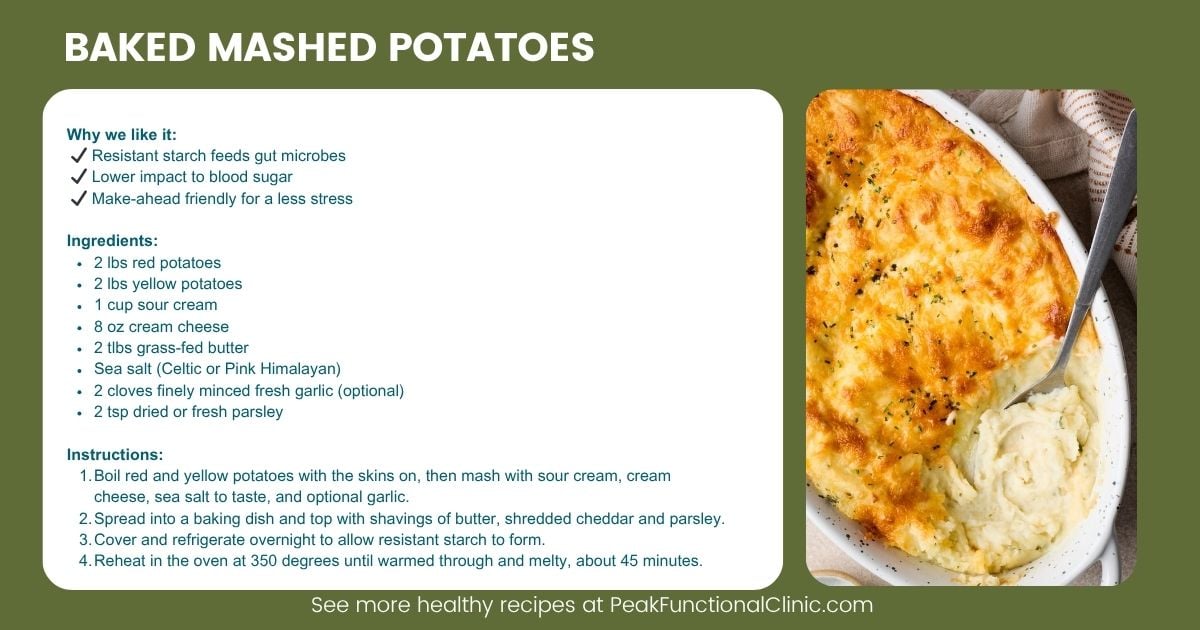Resistant Starch: The Secret Weapon for Your Gut (and Glucose)

Make a whole food even better + recipe
As Thanksgiving rolls around, many of us feel a little more adventurous at the table. Whether it's mashed potatoes, fluffy yam casserole, or a warm rice pilaf, the holiday season brings comfort, and quite a bit more carbohydrates. But with those, especially when insulin sensitivity is a concern, come challenges: blood sugar swings, gut discomfort, and even dips in immunity.
That said, the holidays don’t have to derail your health goals. One of the strategies I’ve leaned into over the years is resistant starch, a kind of carbohydrate that doesn’t behave like most carbs. It doesn’t spike your blood sugar the way digestible starches do. Instead, it slips by the small intestine, makes its way to the colon, and feeds your gut microbiome.
And for many of us walking the functional nutrition path, that’s a win-win: you get some of the foods you love and support long-term metabolic and gut health.
What Is Resistant Starch?
Resistant starch is a special type of carbohydrate that resists digestion in the small intestine. Because of that, it arrives in the large intestine largely intact, where your gut microbes ferment it. This fermentation produces short-chain fatty acids (SCFAs), particularly butyrate, which has many protective and regulatory effects.
Here’s why that’s powerful:
Butyrate production: Butyrate is one of the SCFAs generated when gut bacteria feed on resistant starch. It’s especially important for colon health, supports the gut barrier, and can help calm inflammation. While butyrate is a fuel for gut cells, it can also be metabolized into the ketone body beta-hydroxybutyrate, an alternative metabolic fuel to glucose.
Regulating appetite & insulin: In animal studies, resistant starch increases gut hormones like GLP-1 (glucagon-like peptide-1) and PYY, which help regulate hunger and support insulin sensitivity.
Better glucose response: Meta-analyses show that resistant starch reduces post-meal blood sugar and, over time, may improve fasting glucose, even in people with prediabetes.
Where You'll Find Resistant Starch
Resistant starch isn’t another obscure supplement, you can get it from real food. Natural sources include unripe fruit like green bananas and plantains. You can also increase the amount of resistant starch in certain foods by cooking and then cooling them. Research shows that this cook-and-cool method, even with reheating, can significantly boost resistant starch levels over several days while still allowing you to enjoy these foods in moderation. This works especially well with potatoes, rice, yams, beans, lentils, chickpeas, and gluten-free oats.
That means your Thanksgiving spreads can be strategically prepared to support resistant starch. For example, cooking mashed potatoes a day ahead and reheating them later isn’t just convenient, it’s functionally beneficial.
Why This Matters for Long-Term Health
We all know that highly restrictive diets can backfire, especially long-term. Functional nutrition isn’t about deprivation, it’s about strategic inclusion. Resistant starch gives us a way to enjoy comforting, familiar carbs in a smarter way, supporting both blood sugar balance and gut health.
Plus, the fermentation of resistant starch (and the butyrate that results) is not just good for digestion, it has systemic effects. Butyrate has been shown to influence gene expression in ways that support anti-inflammatory pathways/ And the increase in GLP-1 and PYY suggest that resistant starch helps us manage hunger and improve insulin sensitivity naturally.
How does resistant starch compare in blood glucose? Check out this short video comparison.
Mashed Potatoes are Back on the Menu
Mashed potatoes have long been a favorite of mine, a creamy, nostalgic staple I look forward to every year. But as I’ve worked to improve my own blood sugar balance, I realized I needed a better strategy than simply “don’t eat the potatoes.”
So now, I make mine a day or two before. After boiling red and yellow potatoes (skin on), I mash them with sour cream, cream cheese, and garlic if I’m feeling bold. Then I top them with cheddar and parsley, refrigerate overnight, and bake on Thanksgiving day until warm and melty.
Because I cooked, cooled, and reheated them, I’ve increased the resistant starch helping tone down the glucose bump while feeding my gut microbes.
Of course, that doesn’t mean going wild with portions. I stick to moderate servings (around 4–6 oz) and recommend introducing resistant-starch-rich foods gradually to avoid gas or bloating if they’re new to your system.
Bottom line: You don’t have to skip your favorite traditions to be health-conscious. With a little planning and awareness, you can enjoy your favorite sides and support your long-term metabolic and gut health. A bowl of reheated, thoughtfully made mashed potatoes? That’s a holiday win, for your soul, and for your microbiome.

References:
Baptista NT, Dessalles R, Illner AK, Ville P, Ribet L, Anton PM, Durand-Dubief M. Harnessing the power of resistant starch: a narrative review of its health impact and processing challenges. Front Nutr. 2024 Mar 20;11:1369950. doi: 10.3389/fnut.2024.1369950. PMID: 38571748; PMCID: PMC10987757.